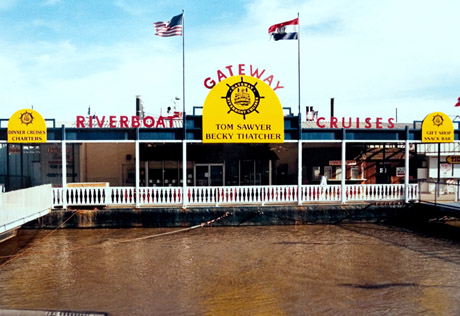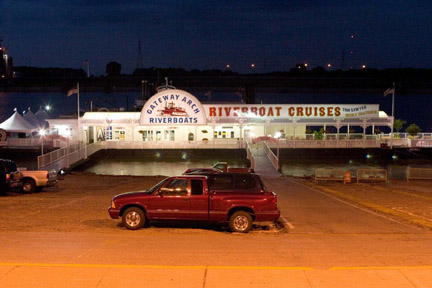When Metro, operator of the St. Louis Metropolitan region’s transportation system, purchased the Gateway Arch Riverboat Cruises in 2002, managers soon determined that a major refurbishing in signage, graphics and architectural details on the riverboats’ barge was required to build steam into visitor numbers. The Tom Sawyer and Becky Thatcher 19th-century steamboat replicas, which make up the Gateway Arch Riverboat Cruises line, are docked on the Mississippi River in downtown St. Louis directly below the 630-foot tall stainless steel Gateway Arch, operated by the National Park Service as part of the Jefferson National Expansion Memorial. 
Metro estimates that 69 percent of tourists to St. Louis visit the Gateway Arch Riverfront campus, according to Tom Etling, director of sales and marketing, Gateway Arch Riverfront, which includes the Gateway Arch, Old Courthouse and Gateway Arch Riverboats. Fifty-nine percent of those tourists visit the Gateway Arch and 10 percent visit the Gateway Arch Riverboat Cruises, he said. A total of 170,000 guests annually enjoy sightseeing, dinner, specialty and charter cruises. (Metro operates the Gateway Arch Transportation System, including its tram ticketing and reservation center, the Gateway Arch Riverboats and the Arch Parking Facility adjacent to the Arch grounds.)
“We encourage visitors to spend more time with us through marketing the Gateway Arch Riverfront as a campus,” said Etling.
While the architectural wonder of the gleaming Gateway Arch thrust high above the St. Louis skyline since 1965 is enough to attract the attention of any tourist, Etling said the riverboats needed striking visuals of their own to help entice visitors to embark upon a sightseeing or dinner cruise and to enjoy casual dining at the Arch View Café on the riverboats’ docking barge. While the riverboats are visible from the Arch, guests must be drawn to walk down a series of steps from the Jefferson National Expansion Memorial grounds to the riverboats’ barge to gather information about cruises.
“Although they needed some updating and better maintenance, the riverboats were in good shape when Metro purchased the business,” said Etling. “But the barge and dock area needed a great deal of work. Metro recognized how nice the boats (built in 1964-1966) looked and that the majority of visitors come down to the riverboats from the Arch grounds. The old signage (vinyl lettering on canvas encased in metal frames) had served its purpose. The barge needed a fresh new look.”
New signage created from Dibond® graphic display board and Alucobond® material by 3A Composites USA was included in an architectural update of the riverboat barge designed by the St. Louis office of Peckham Guyton Albers & Viets, Inc. (PGAV), a firm of architects, urban consultants and planners.
(Among PGAV’s destination/attraction clients are Busch Gardens, The Audubon Nature Institute, National Geographic, Bass Pro Shops, The Hoover Dam, Discovery Cove, The Niagara Parks Commission, The National Aviary, The Georgia Aquarium, SeaWorld Adventure Parks and Universal Studios.)
“We needed to create an environment reminiscent of riverboat travel in the late-1800s by renovating the barge architecture – adding architectural details like rails, brackets and finials – and by creating a system of themed signage,” said Alexandra Guillossou, exhibit designer, PGAV. “The original layout of the barge and the signage did nothing to create a sense of ‘place.’ The new signage and architectural improvements aim to do that.”
In designing the signage, Guillossou said she focused on the period look of riverboats that steamed up and down the Mississippi during author Mark Twain’s day – “large, white boats with decorative rails and brackets that were identified in large, bold type” – and included a semicircular shape in the main sign to evoke the feel of a riverboat paddlewheel.
“The main sign and the entry signs, which also feature period type, help the entire barge appear more like a riverboat,” she said.
Additionally, the main sign was designed to draw attention to the riverboat cruises from the Arch steps, according to Guillossou. It succeeds in doing so with its grand scale. The white semicircular sign featuring the image of a period steamboat with paddlewheel and the words “Gateway Arch Riverboats” in blue vinyl lettering stands 16 feet tall and measures 30 feet in diameter. It is positioned adjacent to a white 80-foot-wide by 6.5-foot tall rectangular sign emblazoned with “Riverboat Cruises” in 4-foot-tall red vinyl letters. Individual riverboats Tom Sawyer and Becky Thatcher – named after characters in Mark Twain novels – are listed in blue and gold vinyl lettering at the end of the rectangular sign.
While Dibond graphic display board originally was specified for smaller signs on the barge, including menu boards and café and gift shop locaters, it also proved to be the perfect material for the main sign, according to Ed Brimer, president of Engraphix Architectural Signage, Inc., in St. Louis, which fabricated the riverboat signage.
“The main sign originally was specified to be fabricated from aluminum and painted white; the construction contractor was building a steel structure on the barge to support the sign,” said Brimer, who bid the job through BSI Constructors, Inc., a St. Louis-based construction management and general contracting firm. “But white Dibond was right for this application. You don’t have to paint it. It offers more stiffness than aluminum and it costs less than aluminum. There’d be no painting or prep time with Dibond. With aluminum, you have to sand both sides, clean the surface with a lacquer thinner, and then apply a metal primer and paint. Those steps triple the cost.”
Dibond is an easy-to-fabricate lightweight-yet-rigid aluminum composite material consisting of two pre-painted sheets of .012-inch aluminum bonded to a solid polyethylene core – a unique composition that makes it approximately one-half the weight of aluminum. Dibond, the flattest panel on the market, offers a superior surface that protects expensive digital and screen-printed graphics. Dibond won’t bow or oil can, and it offers excellent durability in outdoor applications.
Dibond colors include white/white, white/black, dark bronze/fine silver, hunter red/caution yellow and ultra marine blue/white. A polyester clear coat is applied over Dibond’s brushed aluminum finish to create Dibond Brushed Silver and Dibond Brushed Gold.
Engraphix utilized 40 sheets of 4-foot by 8-foot white Dibond in the 3 mm thickness to construct the riverboat signage, spending approximately eight weeks in engineering/structural design and fabrication.
The semicircular sign was cut with a Gerber Sabre router and fabricated in four sections for transportation to the job site. The riverboat image, designed by PGAV, was digitally printed using 3M Scotchprint® Graphics onto white vinyl with an adhesive backing and finished with a clear lamination film. The image outline was hand cut by Engraphix staff. Dentil molding decorating the semicircular sign piece was cut with a Gerber Sabre router from Sign•Foam3®, a high-density polyurethane board by Sign•Arts Products Corp., and painted gray. The dentil molding was attached with concealed screws positioned through holes drilled in the back of the Dibond.
Vinyl lettering on both the semicircular and rectangular sign pieces featured multiple layers of color, producing a drop-shadow effect and 1800s period look. Each letter was hand-positioned and applied to the Dibond. All of the riverboat signs were encased in aluminum tubing as a structural framework device and to create a visual border, according to Brimer.
Engraphix chose to construct a third large graphic display piece – a 9-foot-tall by 6-foot-wide period clock – from a 62-inch by 196-inch sheet of 6 mm white Alucobond composite material. A white Dibond sign announcing “Next Cruise” in red vinyl lettering is positioned beneath the clock.
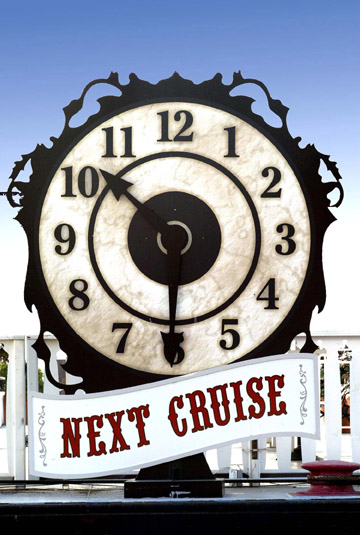
Alucobond consists of two sheets of smooth .02-inch aluminum thermobonded to a polyethylene core in a continuous process. Alucobond is pre-finished with a premium Kynar® coil coating that is available in a spectrum of standard colors as well as custom colors. Alucobond comes in a variety of lengths and widths.
“The Alucobond was sturdier for the wind conditions experienced on the barge, and the extra thickness produced a sense of strength with all of the exposed edges,” said Brimer. “Although PGAV had specified aluminum for the clock, we thought Alucobond was the right material.”
Engraphix hired Craig Jakubs, owner of The Show Doctor Graphic Design in St. Louis, to develop period clock artwork featuring an aged parchment face. Clock numbers were dropped onto the parchment face with Adobe PhotoShop. The created art file was digitally printed using 3M Scotchprint Graphics onto white vinyl. Details, including clock hands, were hand cut; the filigree edge was cut by hand on a reciprocating saber saw. Faces and exposed edges of the Alucobond were painted black by Engraphix employees.
The clock features a complicated mechanism positioned on the back that allows riverboat personnel to change the hands to denote the next cruise time. It is supported by a 4-foot by-4 foot steel framework with a support post bolted to the barge deck. This framework is sandwiched between two sheets of black Dibond cut in a circular shape to conceal the steel from behind.
The clock was built and installed in one piece. The main riverboat signage, however, was constructed in pieces at the Engraphix shop, taken apart for transportation to the Mississippi Riverfront via flatbed truck and reassembled there for installation on Feb. 23-24, 2005. Metal pieces were glued to each seam in the sign pieces, which were screwed to aluminum frames.
Engraphix hired Piros Signs, Inc., of Barnhart, Mo., to install the large signage with two cranes – one to lift the sign pieces and another to lift the employee completing installation over 50 feet of water in front of the docked barge.
“It was two tense days of installation,” said Brimer. “Our signs had to fit within an inch of the steel roll forms and metal beams that were welded onto the barge to provide structural strength for the signs. We pre-measured to help ensure a perfect fit. We were standing on the ground during our sign installation and looking up at the real Arch. We really wondered how they did that!”
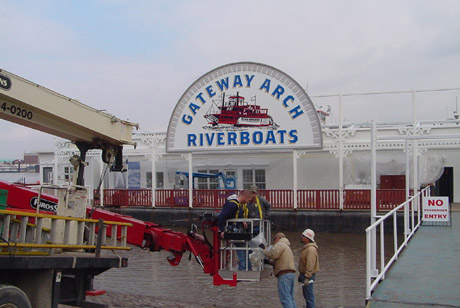
The signs fit the framework, and Brimer credits the successful installation to careful planning.
“We planned really well with all of our brackets and attachments; their arc and our arc met perfectly,” according to Brimer, who said that this signage project was one of the largest ever fabricated by Engraphix and “the only one over water.”
Metro’s goal was to have the new signage installed before St. Louis hosted the 2005 NCAA® Final Four® Men’s Division I Basketball Championship April 2-4 in an effort to attract some of the tournament goers to the Gateway Arch Riverboat Cruises.
“The Final Four was the biggest event that St. Louis had hosted since the 1904 World’s Fair,” said Etling. “We’ve seen a carryover effect from the visibility of that event and the Arch aerial photos. Visitors from our key feeder markets have told other people about their experience here. Our numbers (on the riverboat cruises) were definitely up; it was a very good weekend.”
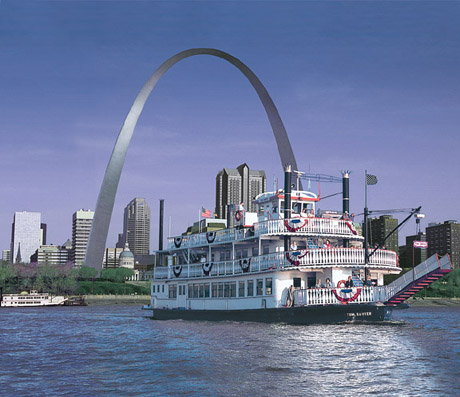
Etling gives the new signage a great deal of credit for drawing the notice of visitors on the Arch grounds to the riverboat cruises.
“This signage is big and colorful; that’s really important,” said Etling. “It helps to attract people to come down from the Arch steps. The color on these signs really pops and increases their visibility. They’re also durable. And, the new graphics are more in line with the quality of entertainment and food that visitors can expect.”


